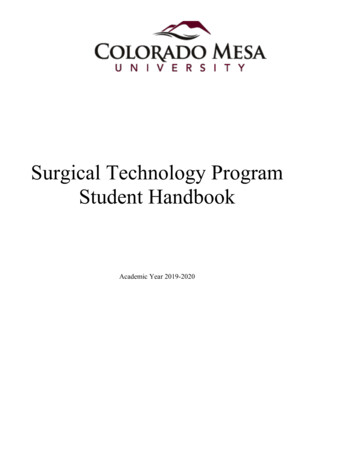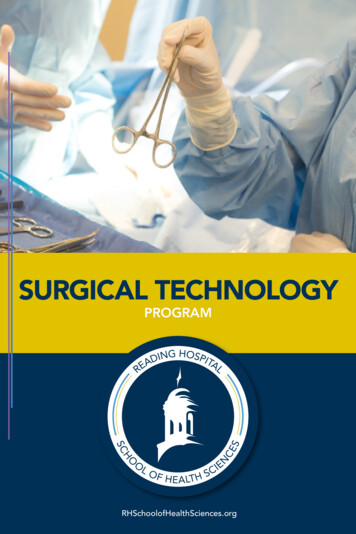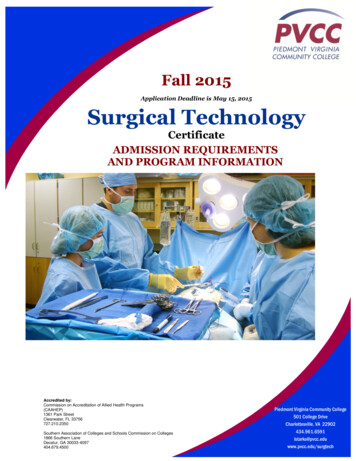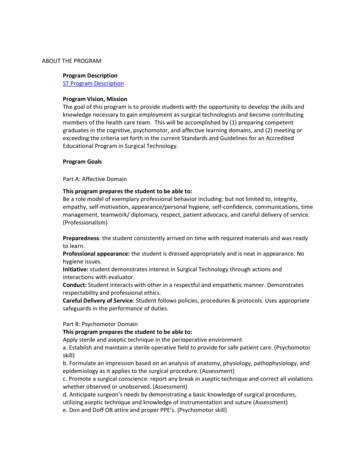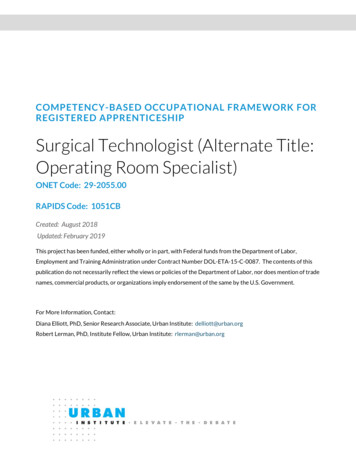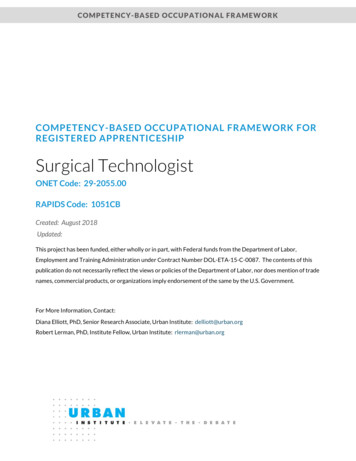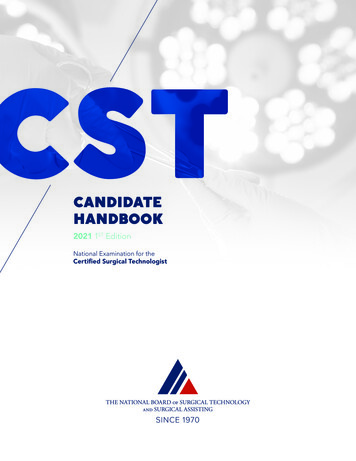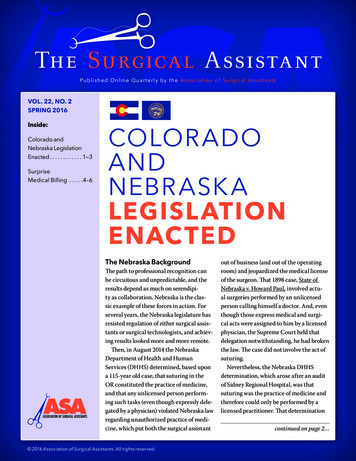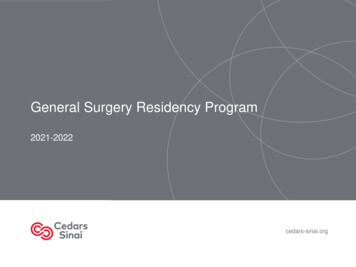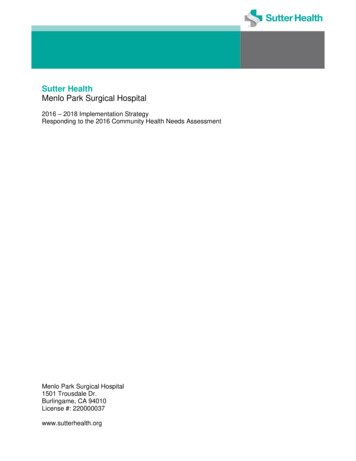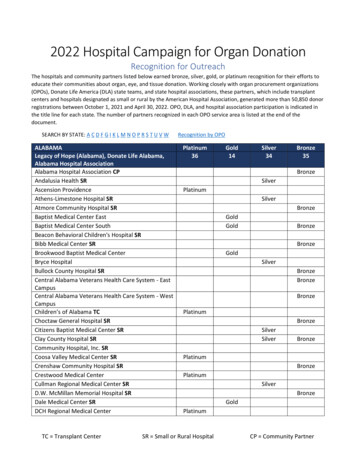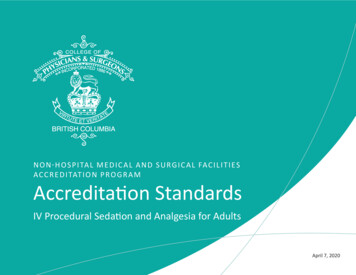
Transcription
N O N-H O S P I TA L M E D I C A L A N D S U R G I C A L FA C I L I T I E SA C C R E D I TAT I O N P R O G R A MAccreditation StandardsIV Procedural Sedation and Analgesia for AdultsApril 7, 2020
NON-HOSPITAL MEDICAL AND SURGICAL FACILITIES ACCREDITATION PROGRAMAccreditation StandardsIV Procedural Sedation and Analgesia for AdultsINTRODUCTIONIntravenous procedural sedation and analgesia must only be performed in non-hospital facilities accredited by the College of Physicians andSurgeons of BC. IV procedural sedation and analgesia is administered to provide analgesia and amnesia resulting in depression of the patient’slevel of consciousness so as to facilitate the performance of a diagnostic, therapeutic or invasive procedure and to minimize the adversepsychological effect associated with the procedure. IV procedural sedation and analgesia medications are to be administered in smallincremental doses that are titrated until the desired level of sedation/analgesia is achieved.As per the American Society of Anesthesiologists’ (ASA) Continuum of Depth of Sedation, the functional characteristics of minimal and moderatesedation are as follows:Minimal sedation (anxiolysis) is a drug-induced state during which the patient responds normally to verbal commands, and althoughcognitive function and coordination may be impaired, ventilatory and cardiovascular functions are unaffected.Moderate sedation is a drug-induced depression of consciousness during which the patient responds purposefully to verbal commands,either alone or accompanied by light tactile stimulation. No interventions are required to maintain a patent airway, spontaneousventilation is adequate and cardiovascular function is usually maintained.Deep sedation is a drug-induced state during which the patient cannot be easily aroused but responds purposefully following repeatedor painful stimulation. Reflex withdrawal from a painful stimulus is not considered a purposeful response. Airway intervention may berequired, and spontaneous ventilation may be inadequate. Cardiovascular function is usually maintained.Patients displaying the functional characteristics of moderate sedation must be monitored in accordance with the requirements for moderatesedation. When the intended level of sedation is moderate sedation, patients must be monitored in accordance with the requirements formoderate sedation.When administering IV procedural sedation and analgesia medications intended for general anesthesia (e.g. propofol, ketamine, etomidate),patient care must be consistent with that required for general anesthesia, and the physician administering any of these medications must beable to identify and manage patients from unintended deep sedation or general anesthesia. Other regulated health professionals (e.g. registerednurses) are not permitted to prepare and/or administer IV procedural sedation and analgesia medications intended for general anesthesia (e.g.propofol, ketamine, etomidate).IV Procedural Sedation and Analgesia for AdultsApril 7, 20201 of 18
ACCREDITATION STANDARDSThis standard does not apply to: general or major conduction anesthesia (e.g. spinal or epidural/caudal block), peripheral nerve blocks, local ortopical anesthesia, 50% or less nitrous oxide in oxygen with no other sedative or analgesia medications by any route or single, oral sedative, oranalgesic medication administered in doses appropriate for the treatment of anxiety or pain.IV Procedural Sedation and Analgesia for AdultsApril 7, 20202 of 18
ACCREDITATION STANDARDSIVS1.0IV PROCEDURAL SEDATION AND ANALGESIA FOR ADULTSIVS1.1Anesthesiologists who administer IV procedural sedation/analgesia are qualified.Guidance: This section applies to IV procedural sedation and analgesia under the care of an anesthesiologist.IVS1.1.1MEach anesthesiologist is licensed with the College of Physicians and Surgeons of BC.Guidance: The medical director confirms anesthesiologist licensure from the College annually.IVS1.1.2MEach anesthesiologist holds non-hospital privileges.Guidance: IV procedural sedation and analgesia under the care of an anesthesiologist includes: anesthesiologist assessment andmanagement of a patient during a procedure or treatment; administration of intravenous sedatives, hypnotics, analgesics andanesthetic medications commonly used for the induction/maintenance of general anesthesia (GA); recognizing “deep” sedation,managing its consequences and adjusting the level of sedation to a “moderate” or lesser level; being able to convert to a GA whennecessary and intervene to rescue a patient’s airway and allow for the safe administration of a maximal depth of sedation in excess ofthat provided during intravenous procedural sedation administration.IVS1.1.3MEach anesthesiologist that has not practiced anesthesia in a hospital setting within three years holds current ACLS training.Guidance: Anesthesiologists that hold hospital privileges in the practice of anesthesia or that did hold hospital privileges in thepractice of anesthesia within the last three years are not required to hold current ACLS training. ACLS courses may be taken directlythrough the Heart and Stroke Foundation of Canada (HSFC) and/or from a third-party provider. Medical directors must ensure thirdparty providers instruct in accordance to the HSFC guidelines. Following initial certification, re-certification is required every two years.IVS1.1.4MEach anesthesiologist that has not practised anesthesia in a hospital setting within three years has completed a difficult airwaymanagement course.Guidance: Anesthesiologists that hold hospital privileges in the practice of anesthesia or that did hold hospital privileges in thepractice of anesthesia within the last three years are not required to have completed a difficult airway management course. Coursesmay be taken through a third-party provider. Medical directors must ensure that the course content includes both theory and inperson/hands-on components which meet necessary skills competencies for the non-hospital setting. Difficult airway managementcourse re-certification must be completed every three years.IVS1.2Physicians who administer or direct the administration of IV procedural sedation and analgesia are qualified.Guidance: This section applies to non-anesthesiologist physicians who administer and or direct the administration of IV procedural sedationand analgesia (IV-PSA).IVS1.2.1MEach physician is licensed with the College of Physicians and Surgeons of BC.Guidance: The medical director confirms physician licensure from the College annually.IV Procedural Sedation and Analgesia for AdultsApril 7, 20203 of 18
ACCREDITATION STANDARDSIVS1.2.2MEach physician holds non-hospital facility privileges to provide IV procedural sedation and analgesia (IV-PSA).Guidance: Intravenous procedural sedation and analgesia (IV-PSA) may be administered by qualified non-anesthesiologist physicians.Physicians administering or directing the administration of IV-PSA must be able to recognize “deep” sedation, manage itsconsequences, and adjust the level of sedation to a “moderate” or lesser level. IV-PSA includes assessment and management of apatient during a procedure or treatment, and administration of sedatives, hypnotics and analgesics only. Medications used for theinduction/maintenance of general anesthesia (e.g. propofol) must not be administered by non-anesthesiologists. Non-anesthesiologistphysicians who administer ketamine possess the requisite training and currency and have been granted special privileges by themedical director to administer IV ketamine. Ketamine will produce general anesthesia and must be used with caution as there is nospecific reversal agent. Although associated with less cardiorespiratory depression than other sedatives, airway obstruction,laryngospasm and pulmonary aspiration may occur with ketamine use. IV-PSA ketamine administered by a non-anesthesiologistphysician is limited to a single weight-based dose of 0.25 mg/kg to a maximum dose of 20 mg.IVS1.2.3MEach physician that administers or directs the administration of IV-PSA has completed post-graduate training in IV proceduralsedation.Guidance: Physicians, dentists, oral maxillofacial surgeons or podiatric surgeons who personally administer and/or direct theadministration of IV-PSA have completed post-graduate training in IV procedural sedation. IV procedural sedation courses may betaken through a third-party provider. Medical directors must ensure that the course content includes both theory and inperson/hands-on components which meet necessary skills competencies for the non-hospital setting. IV procedural sedation refreshertraining is required every five years. At the discretion of the medical director, physicians, dentists, oral maxillofacial surgeons orpodiatric surgeons currently administering and/or directing the administration of IV-PSA that have not completed post-graduatetraining in IV procedural sedation within the last 5 years may be grandparented until June 2021, after which time evidence of IVprocedural sedation refresher training must be on file.IVS1.2.4MEach physician that administers or directs the administration of IV-PSA holds current ACLS training.Guidance: Physicians that administer or direct the administration of IV-PSA must possess the requisite knowledge and skills to assessthe patient care requirements during procedural sedation and recovery. The medical director is responsible for ensuring facility staffhave the proper qualifications, training and knowledge and possess the competencies required for their role, which would include allspecialized skill courses such as Basic Life Support (BLS) Provider, ACLS and airway management. ACLS courses may be taken directlythrough the Heart and Stroke Foundation of Canada (HSFC) and/or from a third-party provider. Medical directors must ensure thirdparty providers instruct in accordance to the HSFC guidelines. Following initial certification, re-certification is required every two years.IVS1.3Registered nurses who administer IV procedural sedation or monitor a patient under IV procedural sedation are qualified.IVS1.3.1MEach registered nurse holds practising registration with the British Columbia College of Nursing Professionals.Guidance: Registered nurses (RN) are the only other regulated health professional whose scope of practice may include IV proceduralsedation. It is not within a licensed practical nurse’s (LPN) scope of practice to administer medications for the purposes of proceduralsedation. LPNs who may be involved in the monitoring of patients under IV procedural sedation do so in a team-nursing approachwith an RN (i.e. the RN is present in the room at all times).IV Procedural Sedation and Analgesia for AdultsApril 7, 20204 of 18
ACCREDITATION STANDARDSIVS1.3.2MEach registered nurse has completed a procedural sedation management course.Guidance: Registered nurses that administer IV-PSA or monitor a patient under IV-PSA must possess the competencies required tocarry out this activity. IV procedural sedation courses may be taken through a third-party provider. Medical directors must ensure thatthe course content includes both theory and in-person/hands-on components which meet necessary skills competencies for the nonhospital setting. IV procedural sedation refresher training is required every five years. At the discretion of the medical director,registered nurses currently administering and/or monitoring patients under IV-PSA that completed an IV procedural sedationmanagement course more than 5 years ago may be grandparented until June 2021, after which time evidence of IV proceduralsedation refresher training must be on file. Post-anesthesia care registered nurses are not required to complete a procedural sedationmanagement course as they acquire the necessary education to administer IV sedation and/or monitor a patient under IV sedationthrough their education and experience in critical care/post-anesthesia care nursing. Post-anesthesia care registered nurses are notrequired to complete IV procedural sedation refresher training provided they have worked in a hospital post-anesthesia care unitand/or critical care unit within the last three years.IVS1.3.3MEach registered nurse holds current ACLS training.Guidance: Registered nurses that administer IV-PSA or monitor a patient under IV-PSA must possess the requisite knowledge and skillsto assess the patient care requirements during procedural sedation and recovery. ACLS courses may be taken directly through theHeart and Stroke Foundation of Canada (HSFC) and/or from a third-party provider. Medical directors must ensure third-partyproviders instruct in accordance to the HSFC guidelines. Following initial certification, re-certification is required every two years.IVS1.4The procedure room is appropriately staffed during IV procedural sedation and analgesia under the care of an anesthesiologist andwhen both the scrub and circulating roles are required for the procedure being performed.IVS1.4.1MAn anesthesiologist is dedicated to the operating/procedure room from the start to the finish of each procedure.Guidance: A minimum of four health professionals are dedicated to the operating/procedure room from the start to the finish of eachprocedure: the anesthesiologist administers the IV procedural sedation and analgesia and is solely dedicated to the monitoring of thepatient, the physician who performs the procedure, the scrub nurse, and the circulating nurse. For example, cataract proceduresperformed under MAC require a scrub nurse and a circulating nurse in addition to the anesthesiologist administering and monitoringthe patient under IV procedural sedation.IVS1.4.2MA physician is dedicated to the operating/procedure room from the start to the finish of each procedure.Guidance: A minimum of four health professionals are dedicated to the operating/procedure room from the start to the finish of eachprocedure: the anesthesiologist administers the IV procedural sedation and analgesia and is solely dedicated to the monitoring of thepatient, the physician who performs the procedure, the scrub nurse, and a circulating nurse.IV Procedural Sedation and Analgesia for AdultsApril 7, 20205 of 18
ACCREDITATION STANDARDSIVS1.4.3MA perioperative scrub nurse is dedicated to the operating/procedure room from the start to the finish of each procedure.Guidance: A minimum of four health professionals are dedicated to the operating/procedure room from the start to the finish of eachprocedure: the anesthesiologist administers the IV procedural sedation and analgesia and is solely dedicated to the monitoring of thepatient, the physician who performs the procedure, the scrub nurse, and a circulating nurse. The scrub role is assigned to either aperioperative RN or an LPN who has completed a perioperative nursing program. In this staffing scenario, the scrub nurse and thecirculating nurse are not administering and/or monitoring the patient under IV procedural sedation and analgesia and therefore arenot required to have completed a procedural sedation management course and hold current ACLS.IVS1.4.4MA perioperative registered nurse is dedicated to the operating/procedure room from the start to the finish of each procedure.Guidance: A minimum of four health professionals are dedicated to the operating/procedure room from the start to the finish of eachprocedure: the anesthesiologist administers the IV procedural sedation and analgesia and is solely dedicated to the monitoring of thepatient, the physician who performs the procedure, the scrub nurse, and a circulating nurse. In accordance with the Operating RoomNurses Association of Canada (ORNAC), the primary circulating role shall be assigned only to a perioperative registered nurse. In thisstaffing scenario, the scrub nurse and the circulating nurse are not administering and/or monitoring the patient under IV proceduralsedation and analgesia and therefore are not required to have completed a procedural sedation management course and hold currentACLS.IVS1.5The procedure room is appropriately staffed during IV procedural sedation and analgesia under the care of an anesthesiologist andwhen the circulating role is required for the procedure being performed.IVS1.5.1MAn anesthesiologist is dedicated to the operating/procedure room from the start to the finish of each procedure.Guidance: A minimum of three health professionals are dedicated to the operating/procedure room from the start to the finish ofeach procedure: the anesthesiologist administers the IV procedural sedation and analgesia and is solely dedicated to the monitoringof the patient, the physician who performs the procedure, and the circulating RN to assist the physician (i.e. specimens, patientpositioning).IVS1.5.2MA physician is dedicated to the operating/procedure room from the start to the finish of each procedure.Guidance: A minimum of three health professionals are dedicated to the operating/procedure room from the start to the finish ofeach procedure: the anesthesiologist administers the IV procedural sedation and analgesia and is solely dedicated to the monitoringof the patient, the physician who performs the procedure, and the circulating nurse to assist the physician (i.e. specimens, patientpositioning).IVS1.5.3MA nurse is dedicated to the operating/procedure room from the start to the finish of each procedure.Guidance: A minimum of three health professionals are dedicated to the operating/procedure room from the start to the finish ofeach procedure: the anesthesiologist administers the IV procedural sedation and analgesia and is solely dedicated to the monitoringof the patient, the physician who performs the procedure, and a nurse to assist the physician (i.e. specimens, patient positioning). Forprocedures that do not require a scrub role (e.g. endoscopy), only one nurse is required to be present in the circulating role to assistthe physician (i.e. specimens, patient positioning). In this staffing scenario, the nurse is not administering and/or monitoring thepatient under IV procedural sedation and analgesia and therefore is not required to have completed a procedural sedationmanagement course and hold current ACLS.IV Procedural Sedation and Analgesia for AdultsApril 7, 20206 of 18
ACCREDITATION STANDARDSIVS1.6The procedure room is appropriately staffed during IV procedural sedation and analgesia under the care of an anesthesiologist whenthe scrub role and circulating role are not required for the procedure being performed.IVS1.6.1MAn anesthesiologist is dedicated to the operating/procedure room from the start to the finish of each procedure.Guidance: A minimum of two health professionals are dedicated to the operating/procedure room from the start to the finish of eachprocedure: the anesthesiologist administers the IV procedural sedation and analgesia and is solely dedicated to the monitoring of thepatient, and the physician who performs the procedure. When the room is staffed with only two health professionals, there must be athird regulated health professional immediately available to assist in the event of an emergency. The third regulated healthprofessional may be an RN, LPN or another physician.IVS1.6.2MA physician is dedicated to the operating/procedure room from the start to the finish of each procedure.Guidance: A minimum of two health professionals are dedicated to the operating/procedure room from the start to the finish of eachprocedure: the anesthesiologist administers the IV procedural sedation and analgesia and is solely dedicated to the monitoring of thepatient, and the physician who performs the procedure. When the room is staffed with only two health professionals, there must be athird regulated health professional immediately available to assist in the event of an emergency. The third regulated healthprofessional may be an RN, LPN or another physician.IVS1.6.3MA third regulated health professional is immediately available.Guidance: When the room is staffed with only two health professionals, there must be a third regulated health professionalimmediately available to assist in the event of an emergency. The third regulated health professional may be an RN, LPN or anotherphysician.IVS1.7The procedure room is appropriately staffed during IV procedural sedation and analgesia given in the absence of an anesthesiologist(IV-PSA) and when both the scrub role and circulating role are required for the procedure being performed.IVS1.7.1MA physician is dedicated to the operating/procedure room from the start to the finish of each procedure.Guidance: During procedures in the absence of an anesthesiologist, the IV procedural sedation (IV-PSA) is administered by theoperating physician or given by the registered nurse as directed by the non-anesthesiologist physician. A minimum of four healthprofessionals are dedicated to the operating/procedure room: the physician who performs the procedure, orders the medication andmay administer the medication; a registered nurse who is solely dedicated to the monitoring of the patient during IV proceduralsedation (the role of this RN may include the administration of IV procedural sedation); a scrub nurse; and a circulating nurse.IVS1.7.2MA registered nurse is solely dedicated to the monitoring of the patient from the start to the finish of each procedure.Guidance: A minimum of four health professionals are dedicated to the operating/procedure room: the physician who performs theprocedure, orders the medication and may administer the medication; a registered nurse who is solely dedicated to the monitoring ofthe patient during IV procedural sedation (the role of this RN may include the administration of IV procedural sedation); a scrub nurse;and a circulating nurse. In this staffing scenario, the RN solely dedicated to the monitoring of the patient during IV proceduralsedation must have completed a procedural sedation management course and hold current ACLS. The scrub nurse and the circulatingnurse are not administering and/or monitoring the patient under IV procedural sedation and analgesia and therefore are not requiredto have completed a procedural sedation management course and hold current ACLS.IV Procedural Sedation and Analgesia for AdultsApril 7, 20207 of 18
ACCREDITATION STANDARDSIVS1.7.3MA perioperative scrub nurse is dedicated to the operating/procedure room from the start to the finish of each procedure.Guidance: A minimum of four health professionals are dedicated to the operating/procedure room from the start to the finish of eachprocedure: the anesthesiologist administers the IV procedural sedation and analgesia and is solely dedicated to the monitoring of thepatient, the physician who performs the procedure, a scrub nurse, and a circulating nurse. The scrub role is assigned to either aperioperative RN or an LPN who has completed a perioperative nursing program. In this staffing scenario, the RN solely dedicated tothe monitoring of the patient during IV procedural sedation must have completed a procedural sedation management course andhold current ACLS. The scrub nurse and the circulating nurse are not administering and/or monitoring the patient under IV proceduralsedation and analgesia and therefore are not required to have completed a procedural sedation management course and hold currentACLS.IVS1.7.4MA perioperative registered nurse is dedicated to the operating/procedure room from the start to the finish of each procedure.Guidance: A minimum of four health professionals are dedicated to the operating/procedure room from the start to the finish of eachprocedure: the anesthesiologist administers the IV procedural sedation and analgesia and is solely dedicated to the monitoring of thepatient, the physician who performs the procedure, a scrub nurse, and a circulating nurse. In accordance with the Operating RoomNurses Association of Canada (ORNAC), the primary circulating role shall be assigned only to a perioperative registered nurse. In thisstaffing scenario, the RN solely dedicated to the monitoring of the patient during IV procedural sedation must have completed aprocedural sedation management course and hold current ACLS. The scrub nurse and the circulating nurse are not administeringand/or monitoring the patient under IV procedural sedation and analgesia and therefore are not required to have completed aprocedural sedation management course and hold current ACLS.IVS1.8The procedure room is appropriately staffed during IV procedural sedation and analgesia given in the absence of an anesthesiologist(IV-PSA) and when the circulating role is required for the procedure being performed.IVS1.8.1MA physician is dedicated to the operating/procedure room from the start to the finish of each procedure.Guidance: During procedures in the absence of an anesthesiologist, the IV procedural sedation (IV-PSA) is administered by theoperating physician or given by the registered nurse as directed by the non-anesthesiologist physician. A minimum of three healthprofessionals are dedicated to the operating/procedure room: the physician who performs the procedure, orders the medication andmay administer the medication; a registered nurse who is solely dedicated to the monitoring of the patient during IV proceduralsedation (the role of this RN may include the administration of IV procedural sedation); and a nurse (i.e. LPN or RN) to assist thephysician (i.e. specimens, patient positioning).IV Procedural Sedation and Analgesia for AdultsApril 7, 20208 of 18
ACCREDITATION STANDARDSIVS1.8.2MA registered nurse is solely dedicated to the monitoring of the patient from the start to the finish of each procedure.Guidance: A minimum of three health professionals are dedicated to the operating/procedure room: the physician who performs theprocedure, orders the medication and may administer the medication; a registered nurse who is solely dedicated to the monitoring ofthe patient during IV procedural sedation (the role of this RN may include the administration of IV procedural sedation); and a nurse(i.e. LPN or RN) to assist the physician (i.e. specimens, patient positioning). This RN has no other competing responsibilities and issolely dedicated to the monitoring of the patient during IV procedural sedation. The role of this RN may include the administration ofIV procedural sedation as directed by the non-anesthesiologist physician. In this staffing scenario, the RN solely dedicated to themonitoring of the patient during IV procedural sedation must have completed a procedural sedation management course and holdcurrent ACLS. The second nurse is not administering and/or monitoring the patient under IV procedural sedation and analgesia andtherefore is not required to have completed a procedural sedation management course and hold current ACLS.IVS1.8.3MA second nurse is dedicated to the operating/procedure room from the start to the finish of each procedure that requires thecirculating role.Guidance: A minimum of three health professionals are dedicated to the operating/procedure room: the physician who performs theprocedure, orders the medication and may administer the medication; a registered nurse who is solely dedicated to the monitoring ofthe patient during IV procedural sedation (the role of this RN may include the administration of IV procedural sedation); and a nurse(i.e. LPN or RN) to assist the physician (i.e. specimens, patient positioning). In this staffing scenario, the RN solely dedicated to themonitoring of the patient during IV procedural sedation must have completed a procedural sedation management course and holdcurrent ACLS. The second nurse is not administering and/or monitoring the patient under IV procedural sedation and analgesia andtherefore is not required to have completed a procedural sedation management course and hold current ACLS.IVS1.9The procedure room is appropriately staffed during IV procedural sedation and analgesia given in the absence of an anesthesiologist(IV-PSA) when the scrub role and circulating role are not required for the procedure being performed.IVS1.9.1MA physician is dedicated to the operating/procedure room from the start to the finish of each procedure.Guidance: During procedures in the absence of an anesthesiologist, the IV procedural sedation (IV-PSA) is administered by theoperating physician or given by the registered nurse as directed by the non-anesthesiologist physician. A minimum of two healthprofessionals are dedicated to the operating/procedure room: the physician who performs the procedure, orders the medication andmay administer the medication and a registered nurse who is solely dedicated to the monitoring of the patient during IV proceduralsedation (the role of this RN may include the administration of IV procedural sedation). When the room is staffed with only two healthprofessionals, there must be a third regulated health professional immediately available to assist in the event of an emergency. Thethird regulated health professional may be an RN, LPN or another physician.IV Procedural Sedation and Analgesia for AdultsApril 7, 20209 of 18
ACCREDITATION STANDARDSIVS1.9.2MA registered nurse is solely dedicated to the monitoring of the patient from the start to the finish of each procedure.Guidance: A minimum of two health professionals are dedicated to the operating/procedure room: the physician who performs theprocedure, orders the medication and may administer the medication and a registered nurse who is solely dedicated to themonitoring of the patient during IV procedural sedation (the role of this RN may include the administration of IV procedural sedation).This RN may assist with minor interruptible tasks (e.g. opening an additional suture, tying a gown). However, assisting with biopsies,specimens or patient positioning are not considered minor interruptible tasks. In this staffing scenario, the RN sol
ACCREDITATION STANDARDS IV Procedural Sedation and Analgesia for Adults 5 of 18 April 7, 2020 IVS1.3.2 M Each registered nurse has completed a procedural sedation management course. Guidance: Registered nurses that administer IV-PSA or monitor a patient under IV-PSA must possess the competencies required to
